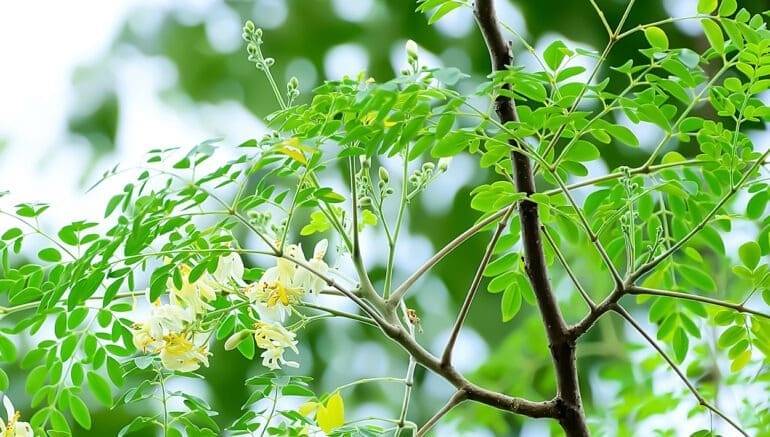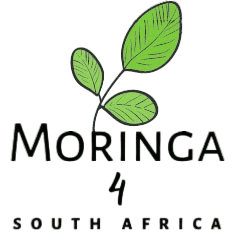
August 10, 2021
In 2008 the American National Institute of Health called Moringa Oleifera the “plant of the year,” acknowledging that “perhaps like no other single species, this plant has the potential to help reverse multiple major environmental problems and provide for many unmet human needs.”
Moringa is the new superfood kid on the block. A lot has been written about its amazing nutrient density and inflammation-fighting abilities. In fact, to date, over 1,300 studies, articles, and reports have focused on Moringa’s healing benefits that are important in parts of the world that are especially susceptible to disease outbreaks and nutritional deficiencies.
Since we are Moringa lovers, we have dug deep into the history and uses of this unique plant. We would like to introduce you to the Moringa tree and show you how it is a thing of beauty and miracles from the tips of its roots to its leafy crown.
What is in a Name?
Around the world, Moringa is known by many names, including “the Miracle Tree” and “l’Arbre de Vie” (Tree of Life). In Senegal, people call it “Dr. Moringa” for its health benefits, or “Nebedaye,” a twist on the English “Never Die,” for its ability to grow in almost any condition and soil type.
Originally from the foothills of the Himalayas, it migrated to many countries in the sub-tropical regions of Africa, Asia, and South America. As the name Nebedaye suggests, Moringa is a tough customer, that will survive both too much and too little water. It is a fast-growing plant that is able to thrive in adverse circumstances like poor soil and severe heat. As a result, aid workers often joke that you can just toss a few seeds on the ground, and something will grow from it!
Moringa to the Rescue
If one had to place a template of those areas on the globe that are most stricken by famine and poverty, it would coincide with the areas where Moringa Oleifera thrives. It grows during what is called “the hungry season” when droughts kill most other crops and vegetation. Consequently, it has been used by health authorities around the world to help combat symptoms of malnutrition for several decades now.
The tree gives so much more than it uses. For instance, as mentioned, it can grow in depleted soil and consequently helps to restore fertility in that soil, which is why it is also used in forest restoration efforts. As the plant progresses through its life cycle, it replenishes diminished minerals and other substances in the earth.
The Moringa Tree has benefited the human race in a myriad of ways during the past 4 000 years. Every single part of the plant can be and is used, especially in rural communities. When we think of Moringa, we picture the leaf products like powder or juice extract, but please allow us to tell you about the rest – it is like a pantry in one plant!
In fact, when it comes to health, this scruffy little tree is nature’s version of a Swiss Army Knife – there’s a little tool for everything, from doubling breastmilk production to treating dysentery.
Let us get to the root of things, so to speak.
Moringa Root
The tree has a fleshy, white taproot. It is often used to make poultices for external use on swollen and inflamed limbs. It contains pterogospermin, an antibiotic that is highly effective in the treatment of cholera (Lizzy et al., 1968). The juice of Moringa root bark cures earaches and toothaches. The root can be peeled, dried, powdered, and mixed with vinegar to be eaten as a condiment.
Moringa Bark
The bark is corky and produces a coarse fibre that is ideal for making mats, ropes, and paper.
Siddhuraju and Becker (2003), as well as Anwar et al. (2007), reported that the bark may cure eye diseases and treat fever. Furthermore, stem bark juice may prevent enlargement of the spleen, destroy tumors, and heal ulcers.
The wood of the tree is soft and not very dense, so is not suitable as firewood or for construction.
Moringa Flowers
The creamy to light yellow flowers are delicate and fragrant. They are a great source of pollen for bees and butterflies. The flowers are edible and are rich in potassium, calcium, and amino acids. Furthermore, Lizzy et al. (1968) reported that Moringa flowers contain an antibiotic that is highly effective in the treatment of cholera.
Moringa Fruit
The fruit looks like drumsticks, hence the name “Drumstick tree”. It can grow up to a metre long and contains up to 26 seeds. The young seed pods are tender and edible. They taste a bit like asparagus. They are eaten as a vegetable and are often pickled as a pantry staple. The fruit/pods are rich in minerals, B-vitamins, protein, beta-carotene, and vitamin A and C.
Moringa Seed
The seeds are about 1cm in diameter and have three whitish, papery “wings”. One could cook and eat them like peas, or roast them. When pressed, they produce the highly sought-after Moringa oil, also commercially known as Ben oil.
One of the most amazing characteristics of Moringa seeds is their ability to decontaminate water. Muyibi and Evision, (1995) reported that the seeds could reduce murkiness in water by up to 99%. Moringa Seeds also have a softening effect on water and reduces its alkalinity. Furthermore, the seeds have antiseptic qualities to treat contaminated water. It even cures arsenic poisoning!
Moringa Seed Oil
The Ben oil pressed from the seeds is sweet and not sticky. As a result, it absorbs completely into the skin and can heal all sorts of skin ailments like eczema, psoriasis, and acne. The oil can reduce gout and arthritis when one applies it topically. Ben oil is very resistant to rancidity due to its high levels of antioxidants. For instance, samples of it were discovered in Pharaoh’s graves… completely unspoiled even thousands of years later!
It is a highly valued base for perfumes as it retains fragrance exceptionally well. Interestingly enough, watchmakers use it as a lubricant!
The oil contains peptides that prevent pre-mature ageing and protects the skin against environmental influences. It is a well-known strengthening and conditioning treatment for hair.
Moringa Leaves
The crowning glory of the tree is its leaves. They contain the highest density of nutrients of any plant on earth. The leaves are little nutritional dynamos, just packed with amino acids, minerals, vitamins, and antioxidants. To be more specific, until now scientists have identified 92 nutrients, 46 antioxidants, 36 anti-inflammatories, 18 amino acids and 9 essential amino acids in Moringa leaves. Have a look at more information here.
Hopefully, you now understand the wort of the Moringa Oleifera tree a bit better. Above all, the impact that this plant can have on communities that are suffering from malnutrition is immense. In addition, there is enormous economic growth potential in Moringa farming, as the plantations are worked by local communities in mostly third-world countries. The more the international market for Moringa supplements grows and expands, the bigger the economical benefit to the people on the ground – literally. Moringa may just be the plant that saves the world from famine.
At Matana Health, we only use the leaves of Moringa trees, as they are safe for everyone to take. The bark and root may cause a woman’s uterus to contract, which can be dangerous to those who are pregnant.
It is vital to choose suppliers of Moringa that can verify their products as organic. Pesticides or other chemicals used to treat and colour the leaves and powder, end up in your body and nullify the benefits of the supplement. Our Moringa is farmed organically in Limpopo, South Africa, on land that is owned and worked on by the local communities. You can be assured that the products are of the highest quality and its production provides employment to many. Local is Lekker!

